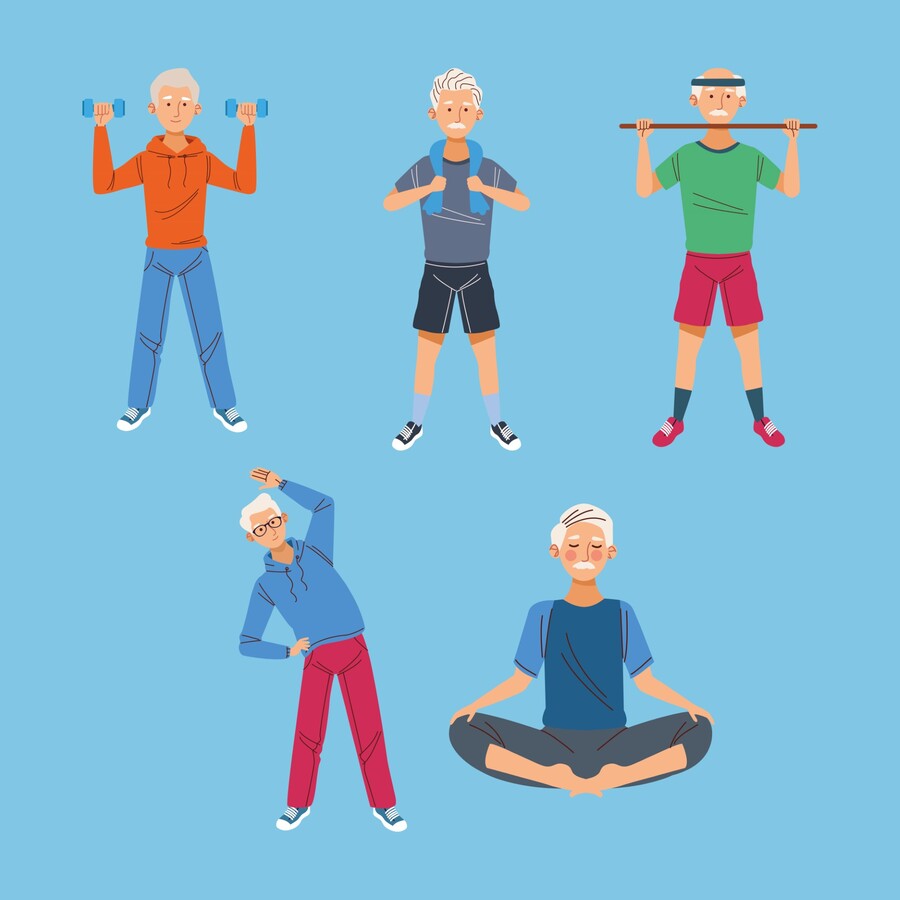Building and maintaining muscle mass is a lifelong process! According to WebMD, both men and women start losing muscle mass as they age. In fact, most people see their muscle mass decrease from 3% to 5% per decade after turning 30. With diminishing muscle mass, mature individuals may become more susceptible to breaking a bone if they fall.
In addition, as stated on WebMD, the risk may be higher for those who suffer with sarcopenia, a syndrome that leads to a gradual loss of bone and muscle. Another reason why some older people may have a hard time holding on to their muscle mass is anabolic resistance, when their skeletal muscle gradually loses the ability to make protein.
Does it mean you should feel discouraged and helpless to stop it? Let us assure you that there are ways to rebuild your muscles and improve your overall well-being, no matter how old you are.
If you take into consideration a few savvy suggestions below, you may be able to increase and preserve your muscle size and improve the quality of your life for many years to come!
These are the crucial steps you can take to address the issue and reverse the process:
The Vital Role of Strength Training
Between ages 50 and 70, people can lose up to 30% of their muscle mass, if they do not engage in strength training. Keep in mind that after 70, the rate of muscle decline accelerates even further, potentially putting us at risk for falls and injuries. These injuries can potentially trigger a cycle that impacts our physical health. Furthermore, after a fall some older people may become a bit more apprehensive, anticipating another accident or fearing another injury. To avoid any potential problems, some individuals may embrace a sedentary lifestyle which, ironically, can increase their risk for more injuries.
Please note that muscle loss can also have an impact on our balance, energy, and daily activities such as walking, exercising, or climbing stairs. Therefore, it goes without saying that regular strength training (if approved by your physician) is essential for maintaining a healthy lifestyle. If you challenge and stimulate your muscles the right way, you can gradually build strength and prevent falls and injuries. You can use resistance bands, dumbbells, weight machines, or even your body weight for your strength training exercise. Just take the time to figure out which activity suits you better and get down to business!
Elevate Your Muscle Growth with Protein
As you may already know, your diet is also crucial when it comes to building your muscle mass. As stated by Harvard Health Publishing, protein is the king of muscle food. Here is why. The body breaks protein down into amino acids, in order to build your muscle strength. In fact, the older you are, the more protein you need. According to Harvard Health Publishing, older adults need a daily intake of 1 to 1.3 grams of protein per kilogram of body weight. If possible at all, try to divide your protein equally among your daily meals, to maximize the muscle building process. You may also benefit from animal sources such as eggs, meat, and milk that are considered the best when it comes to providing the essential amino acids. In addition to that, you may include lean chicken or salmon, plain Greek yogurt, skim milk, and beans, among other healthy choices.
Check Your Vitamin D Levels
Most people are aware that sun exposure is a source of vitamin D that helps develop muscle power. Interestingly, it takes up to four times as long for people over 60 to receive vitamin D through sun exposure. Oftentimes, physicians prescribe a vitamin D supplement which is a great way to bring things back to normal.
Increase Your Mobility and Blood Flow with Walking
Even if you feel tired or lazy, take a walk! The benefits of this simple yet crucial exercise are undeniable. Walking boosts your movement and improves blood flow in your body. Moreover, walking is a fantastic exercise for improving how your body uses insulin, which results in muscle recovery. Remember, even short 10-minute walks during the day can keep your muscles strong and make a difference.
Boost your Omega-3s
You can get your Omega-3s from salmon (mentioned above), walnuts, and flaxseeds. These foods are known to combat inflammation and can be easily incorporated into your diet. In a nutshell, Omega-3 fatty acids are “healthy fats” that support your heart health, according to Cleveland Clinic. Inflammation may cause muscles to break down, therefore, by consuming anti-inflammatory Omega-3s, you are more likely to restore your muscle strength or improve the muscle building process.
As with many facets of health, building and maintaining muscle mass is an ongoing and important health goal. As we age, this becomes even more important to overall health. Let’s control what we can and do everything we can to be our healthiest selves.
The information in the above article is not intended nor implied to be a substitute for professional medical advice, diagnosis, or treatment. Always seek the advice of your physician or other qualified health provider with any questions you may have regarding a medical condition or beginning any exercise program.
